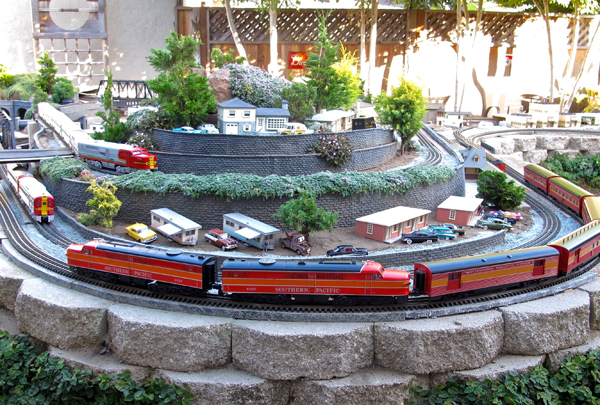
Nancy Lagomarsino and Jacques Verdier are long-time O scale (1:48) collectors. After volunteering at the San Leandro Historical Railway Society’s (www.slhrs.org) G&O Railroad (containing both G and O scales), they were understandably inspired and motivated to dust off their collection to run in the great outdoors.
Choosing O scale gives garden railroaders the advantage of building a smaller layout. If you have a larger space, O scale allows for more scenes with structures and copious plants. At approximately half the scale of large scale (1:48 versus 1:19-24), we need to lean over and examine teeny details, but it’s worth the effort.
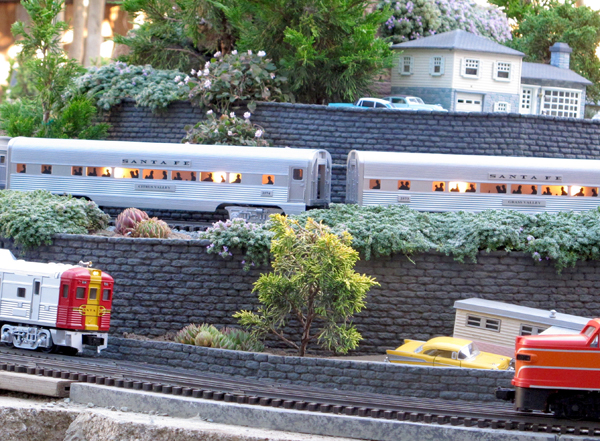
Rare is the garden that enhances O scale trains as well as the Verdi Railroad. Photo 1 presents a broad picture of Jacques Verdier’s peninsula trackplan with 1:43-48 equipment. Photo 2 focuses on Nancy’s living green scenery—Verdi means green. We’ll identify plants that easily could work in your yard, too, whether small or large scale.
Concept and design
To stake out the layout, Jacques snaked a garden hose to outline three projecting masses of land to create distinct habitats for their backyard railway, yet leave plenty of room for walking and viewing. He and Nancy laid out O gauge (three-rail) Atlas-brand track along the hose for 250′ of three main lines on two levels. When they got it right, they raised it all onto keystone blocks, explained in the cover story, “Build a raised railway,” GR October 2016.
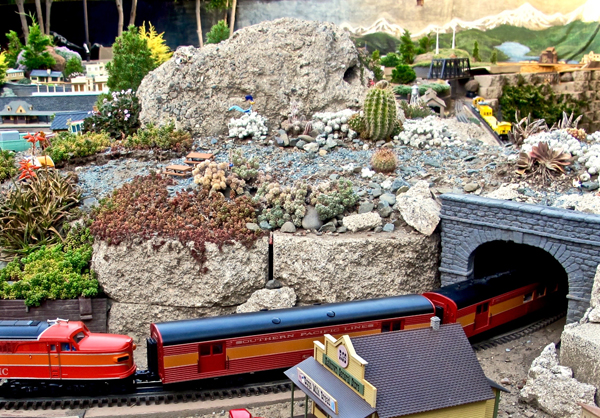
Photos 1, 2, 5 and 6 display the center peninsula, while photos 3 and 4 focus on the right peninsula. We show the left peninsula in Regional reports, where the owners describe their work. Many indoor railways use this lobed technique, which facilitates access and separation of scenes, but in photo 3 we can look across their small backyard (only 1000 sq. ft.) to view the mountains in the distance.
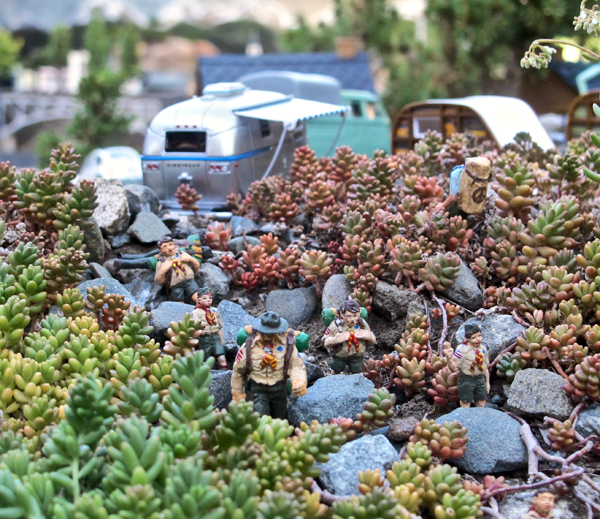
Nancy and Jacques organize their figures and trains in their garden-level storeroom next to the patio. Like using “extras” in the movies, they create stories in the railway just before each open house (photo 5). They generously host G&O members as well as the Train Collectors Association (traincollectors.org) and the Bay Area Garden Railway Society (bagrs.org). Guests often lend a hand (photo 6). Even I happily directed a 1″ Pope to bless the new Copper Gorge from a hot-air balloon (see Regional reports below).
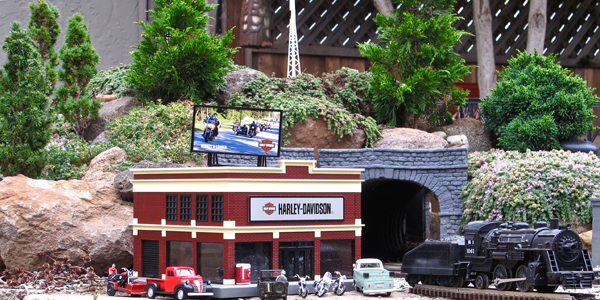
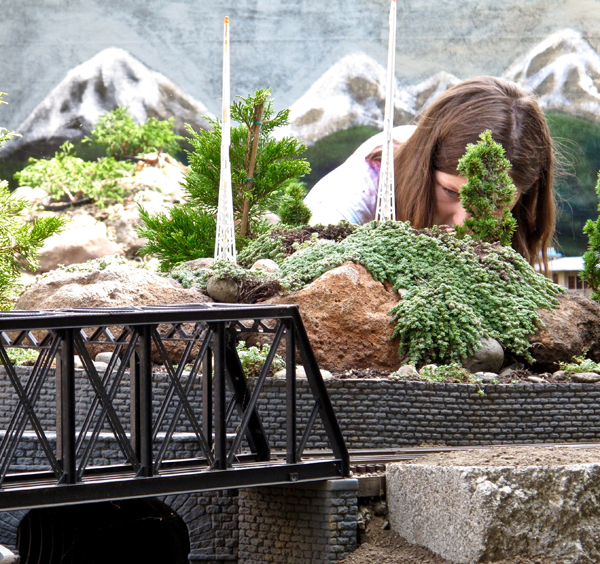
Resources
“A catalog of useful plants,” GR Feb. 2013
“In-scale flowers for the garden railway,” GR Feb. 2008
“An innovative indoor/outdoor O scale line,” GR Aug. 2002
Miniature Garden Guidebook, Kalmbach Media (out of print)
The Garden Railway Manual by C.J. Freezer, Patrick Stephens Limited.
Model landscaping supplies and figures, www.scenicexpress.com
Paul Race’s blog of O scale stories, tinyurl.com/paulraceinO
Regional gardening reports
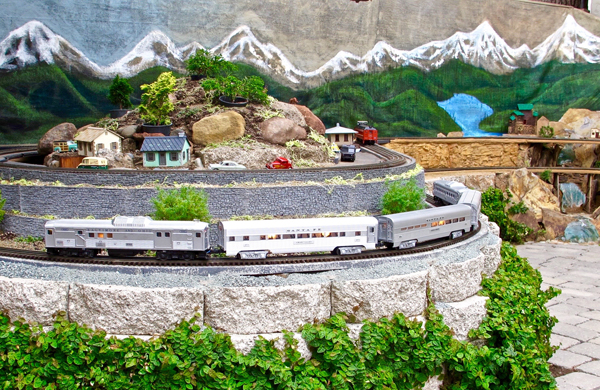
Zones are USDA Hardiness Zones
San Leandro, California, Zones 9-10
O-scale gardening
I make sure that my railroad gardening supports the realism of our O-scale world. I’m careful to choose plants that will stay manageable in size. I only buy plants from reputable growers that are carefully labeled as miniature cultivars and varieties. Growers like Iseli Nursery (www.iselinursery.com), specializing in miniatures and wholesaling to local nurseries) have developed named varieties. Their plant tags provide specific data about final size and growth rate, as well as soil, sun, and moisture requirements. Using a bargain plant of unpredictable habit just isn’t worth the risk.The most important aspect in choosing types of plants is foliage size. Leaves need to be small and believably represent 1:43-1:48-scale; the leaf shape should occur in 1:1 scale in the type of scene I’m aiming at. Branch structure also needs to make sense for the kind of flora I want to show, and internodal distance [between branches] needs to be small.
Careful pruning is often necessary to ensure that branch structure reflects mature plants. I always prune new specimens before I plant them on the layout. When the specimen is in a pot at eye level on a potting bench, it’s much easier to get a good look at the original structure, plan how to shape it, and do the actual cutting.
A variety of landscapes represent different habitats so that all scenes don’t look alike. We have desert flora in one area, a forest in another, and a town in between. This helps meet varying cultural requirements. For example, our 2′ high Mount Acme creates two distinct zones – desert flora on the sunnier west side and a forested camp scene on the shadier side.
The lowest planting of dwarf creeping fig along the retaining wall forces a far-away perspective on everything above. We prune the vines below the top tier of keystones to prevent their migrating to the garden soil above. Root-barrier fabric behind the keystone blocks prevents that.
The painted green 2-D hills reflect the closer 3-D hills of Upper Niles on the far left peninsula of the Verdi Railroad. Gold moss stonecrop will add life between the three retaining walls once the sand-covered cuttings take root.
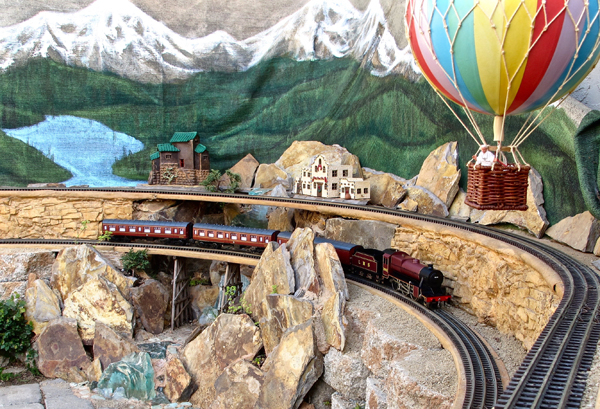
Nancy’s tips for starting tiny plants
• I create a temporary watering basin by cutting a ring about 1½” tall from the top of the nursery pot (usually I work with 3-4″ pots), which I push into the soil around the plant. I cut through the ring so it will be easy to pull off after the plant is well established.
• If I need to plant in hot weather, I create temporary shade over the area with a framework of garden stakes covered by shade cloth.
• I also add water-holding products (like Soil Moist) to the planting soil.
Read more!
Read more about the Verdi Railroad’s water story and its painted backdrops.








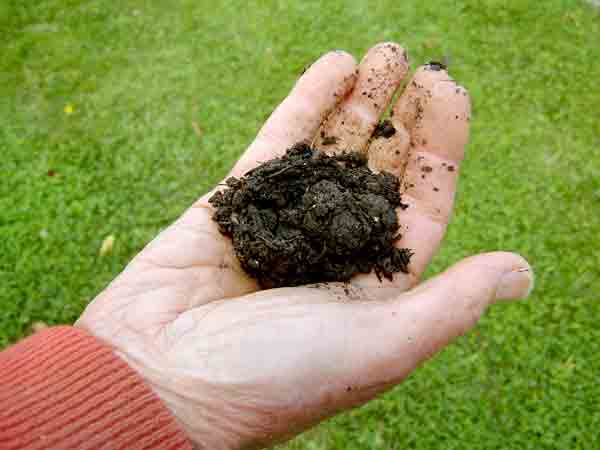





Just not interested in O scale stuff. Sorry….